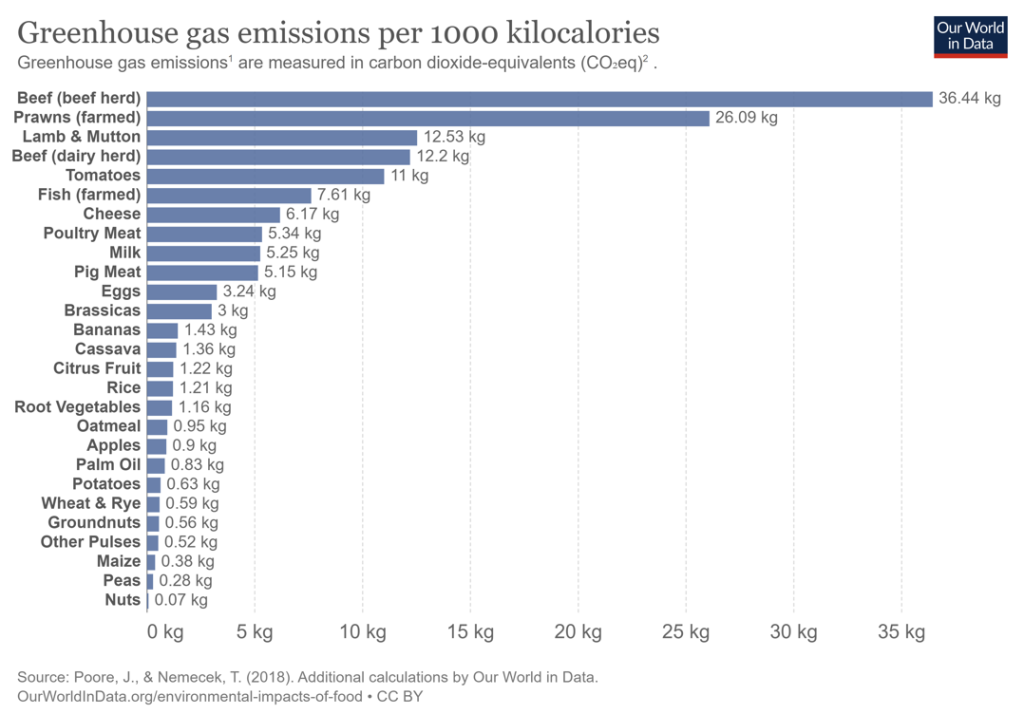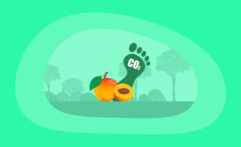What Is the Carbon Footprint of Mushrooms? A Life-Cycle Analysis
Impactful Ninja is reader-supported. When you buy through links on our site, we may earn an affiliate commission.
Learn more
Learn more
.
Hey fellow impactful ninja ? You may have noticed that Impactful Ninja is all about providing helpful information to make a positive impact on the world and society. And that we love to link back to where we found all the information for each of our posts. Most of these links are informational-based for you to check out their primary sources with one click. But some of these links are so-called "affiliate links" to products that we recommend. First and foremost, because we believe that they add value to you. For example, when we wrote a post about the environmental impact of long showers, we came across an EPA recommendation to use WaterSense showerheads. So we linked to where you can find them. Or, for many of our posts, we also link to our favorite books on that topic so that you can get a much more holistic overview than one single blog post could provide. And when there is an affiliate program for these products, we sign up for it. For example, as Amazon Associates, we earn from qualifying purchases. First, and most importantly, we still only recommend products that we believe add value for you. When you buy something through one of our affiliate links, we may earn a small commission - but at no additional costs to you. And when you buy something through a link that is not an affiliate link, we won’t receive any commission but we’ll still be happy to have helped you. When we find products that we believe add value to you and the seller has an affiliate program, we sign up for it. When you buy something through one of our affiliate links, we may earn a small commission (at no extra costs to you). And at this point in time, all money is reinvested in sharing the most helpful content with you. This includes all operating costs for running this site and the content creation itself. You may have noticed by the way Impactful Ninja is operated that money is not the driving factor behind it. It is a passion project of mine and I love to share helpful information with you to make a positive impact on the world and society. However, it's a project in that I invest a lot of time and also quite some money. Eventually, my dream is to one day turn this passion project into my full-time job and provide even more helpful information. But that's still a long time to go. Stay impactful,Affiliate Disclosure
Why do we add these product links?
What do these affiliate links mean for you?
What do these affiliate links mean for us?
What does this mean for me personally?
![]()
Mushrooms are one of the most fascinating parts of the ecosystem; they are actually genetically closer to humans than plants! A single honey mushroom in Oregon is the largest living organism on the planet, and of the 14,000 varieties, mushrooms can do anything from glow in the dark to aiding in the treatment of neurodegenerative diseases. In the culinary world, mushrooms are a tasty and healthy addition to a number of well-known dishes including stews, beef stroganoff, and pies. However, much less is shared about the environmental impact, and especially the carbon emissions of mushrooms. So, we had to ask: What is the carbon footprint of mushrooms?
Mushrooms have a low carbon footprint of 0.12 kg (0.27 lb) of CO2e per pound of produce. They require few resources to grow, are largely grown in the U.S, and can be sold fresh and unpackaged. All of these factors contribute to a very low carbon footprint overall.
In this article, we’ll walk you through the overall carbon emissions of the life-cycle of mushrooms. From growing and packaging to transportation and end-of-life practices, you will learn how this vegetable affects the planet and discover some ways to reduce and offset the footprint.
Here’s How We Assessed the Carbon Footprint of Mushrooms
The carbon footprint is one of the ways we measure the effects of our human-induced global climate change. It primarily focuses on the greenhouse gas (GHG) emissions associated with consumption, but also includes other emissions such as methane (CH4), nitrous oxide, and chlorofluorocarbons, and is generally expressed in carbon dioxide equivalents (CO2e).
“Carbon footprint: the amount of greenhouse gases and specifically carbon dioxide emitted by something (such as a person’s activities or a product’s manufacture and transport) during a given period”
Merriam Webster
Basically, it is the amount of carbon emitted by you as an individual or an organization providing you with goods and services – including mushrooms:
- This includes GHG emissions from producing the products that we use and foods that we eat (e.g., power plants, factories or farms, and landfills)
- GHG emissions from fuel that we burn directly or indirectly (e.g., logistics and transportation, cooling or heating facilities),
- as well as the GHG emissions attributed to how we consume these products and foods.
To understand the carbon footprint of mushrooms, we must assess its life-cycle and each stage’s sustainability. This life-cycle assessment (LCA) is a method to evaluate the environmental impacts of products and materials.
Here’s the Overall Carbon Footprint of Mushrooms
The overall carbon footprint of mushrooms is 0.12 kg (0.27 lb) of CO2e per pound of mushrooms, which is very low in comparison to other foods. They have a similar carbon footprint to root vegetables, such as onions and potatoes, making them one of the least carbon-intensive vegetables. This is mainly because they are domestically grown in the US, and require few resources to grow.
Foraging for mushrooms, as well as using mushroom patterns in fashion and design are on the rise. This trend has been dubbed the ‘mushroom boom of 2022.’ With mushroom consumption increasing, it is important to know the carbon footprint associated with this food type. You can then make sustainable choices when it comes to your diet.
| The carbon footprint of mushrooms | 0.12 kg (0.27 lb) of CO2e per pound of mushrooms |
So, let’s have a look at each stage of the LCA of mushrooms!
| The life-cycle stages of mushrooms | Each stage’s carbon footprint |
| Growing of mushrooms | The carbon footprint of growing mushrooms is 0.07 kg (0.15 lbs) of CO2e per pound of produce, which makes up a large 55.57% of the overall carbon footprint of mushrooms. However, this is a very low amount in comparison to other vegetables, due to the short growth period of mushrooms, as well as their land and water efficiency, and the lack of pesticides required to grow them. |
| Harvesting, processing, and packaging of mushrooms | The carbon footprint of harvesting, processing, and packaging mushrooms is >0.09. kg (>0.2 lbs) of CO2e per pound of produce. This makes up a small 0.26% of the overall carbon footprint of this crop. Mushrooms are often sold loose but they can also be packaged using plastic trays. Opt for unpackaged mushrooms to keep your carbon footprint as low as possible. |
| Transporting of mushrooms | The carbon footprint of transporting mushrooms is 0.05 kg (0.12 lbs) of CO2e per pound of produce, which makes up 44.17% of the overall carbon footprint. This number is low because a short shelf-life reduces the possibility for importing mushrooms from abroad, keeping the carbon footprint relatively small. |
| End-of-life of mushrooms | The carbon footprint of the end-of-life of mushrooms is largely impacted by the amount of food and packaging wasted. Mushrooms make up 2.3% of all avoidable vegetable waste, with 15,000 tons wasted a year. They are the 60th most wasted ingredient. Mushrooms are often sold loose, but when packaged in plastic, their packaging also has a negative impact on the carbon footprint. |
These four stages can be broken down in more detail to understand the factors which impact the carbon footprint of mushrooms.
What Is the Carbon Footprint of Growing Mushrooms
The carbon footprint of growing mushrooms is 0.07 kg (0.15 lbs) of CO2e per pound of produce, which makes up a large 55.57% of the overall carbon footprint of mushrooms. However, this is a very low amount in comparison to other vegetables, due to the short growth period of mushrooms, as well as their land and water efficiency, and the lack of pesticides required to grow them.
Mushrooms grow from spores, in underground networks called mycelium. They require very few resources in comparison to other vegetables, such as cucumber and tomatoes, and because of this, they have a very low carbon footprint.
Which factors impact the carbon footprint of growing mushrooms?
- How do mushrooms grow: The growing process of mushrooms is unique because they are grown from spores as opposed to seeds or bulbs, and thrive in the dark. Spores are multiplied in labs and then mixed into good quality compost. Since mushrooms are often grown in growhouses, the process of temperature regulation can increase the carbon footprint of this stage.
- What is the growth duration of mushrooms: Mushrooms can be incredibly fast growing. The growth process, on average, takes around 14 weeks from preparing the compost. The actual growth period of mushrooms can be as short as 3-4 weeks. Faster growing crops tend to need fewer resources than longer growing plants, which is better for the carbon footprint.
- What is the land usage of mushrooms: Mushrooms are incredibly land efficient. One acre of land can produce a million pounds of mushrooms. However, unfortunately, mushroom growing also produces a lot of soil waste. For every kilogram of mushrooms, three kilograms of waste soil is produced, containing straw, manure, and peat. This often ends up in landfill. The land efficiency is part of the reason why the carbon footprint of mushrooms is so low, but more needs to be done to reduce soil waste.
- What is the water usage of mushrooms: 1.8 gallons of water are required to grow a pound of mushrooms. In comparison, tomatoes require 26 gallons to produce a pound of produce. This makes mushrooms incredibly water efficient, meaning that the carbon footprint is low.
- What is the pesticide and fertilizer usage of mushrooms: Mushrooms ranked as the 5th “cleanest” crop, by the Environmental Working Group, meaning that the pesticide usage of this vegetable is very low in comparison to other crops. Pesticides produce carbon emissions through manufacturing, transportation, and application to crops. So, the fact that mushrooms use relatively low levels of pesticides is better for the carbon footprint.
In short, mushrooms have an extremely low carbon footprint. The growing stage of any crop is likely to produce a large percentage of the overall carbon footprint, due to the resources needed to keep crops alive. However, in comparison to most other vegetables, mushrooms require very few resources.
What Is the Carbon Footprint of Harvesting, Processing, and Packaging Mushrooms
The carbon footprint of harvesting, processing, and packaging mushrooms is >0.09. kg (>0.2 lbs) of CO2e per pound of produce. This makes up a small 0.26% of the overall carbon footprint of this crop. Mushrooms are often sold loose but they can also be packaged using plastic trays. Opt for unpackaged mushrooms to keep your carbon footprint as low as possible.
Due to their short shelf-life, mushrooms go through several stages of processing, which negatively impacts the carbon footprint of this crop. Despite this, they are hand-harvested, and do not go through the intensive level of processing that some vegetables like onions or cauliflowers do.
Which factors impact the carbon footprint of harvesting, processing, and packaging mushrooms?
- How are mushrooms harvested: Mushrooms are harvested every 3-5 days in what is called a flush, or bloom. Mushrooms are cropped by hand, and after a few days of regrowth, they can be harvested again. This rapid regrowth keeps the carbon footprint of mushrooms low. Hand-harvesting is labor-intensive but means that carbon-intensive machine harvesters are not used, making the overall carbon footprint low.
- How are mushrooms processed: Mushrooms are usually sold for the fresh market, but their short shelf life means that they have to go through a post-harvest process. This includes washing, blanching, dehydrating and packing, to prevent premature spoilage. They are also sometimes sold pre-sliced or canned. These steps increase the carbon footprint due to the extra resources used.
- How are mushrooms packaged: Mushrooms are often sold loose in cardboard cartons, which is good for the carbon footprint. However, sometimes they are sold in plastic trays wrapped in film to increase shelf life. This increases the carbon footprint of mushrooms, and increases waste. So, aim to purchase loose mushrooms where you can. Mushrooms can actually be made into biodegradable packaging, which would reduce the need for difficult-to-recycle plastic.
In short, the processing stage of mushrooms contributes to the overall carbon footprint of this crop. However, because mushrooms are harvested by hand and often sold unpackaged, the carbon footprint remains low.
What Is the Carbon Footprint of Transporting of Mushrooms
The carbon footprint of transporting mushrooms is 0.05 kg (0.12 lbs) of CO2e per pound of produce, which makes up 44.17% of the overall carbon footprint. This number is low because a short shelf-life reduces the possibility for importing mushrooms from abroad, keeping the carbon footprint relatively small.
The majority of mushrooms are grown in Pennsylvania, but they can be grown all across the United States. Locally grown produce is better for the environment, as the carbon footprint from transportation is smaller.
Which factors impact the carbon footprint of transporting mushrooms?
- Where are mushrooms grown: The largest concentration of mushroom farms in the US is in Kennett Square, Pennsylvania. Almost two thirds of all mushrooms in America are produced in Southeast Pennsylvania, with other mushrooms grown commercially in California, Texas, Maryland, and Oklahoma. Mushrooms are not frequently imported, due to their short shelf-life. Due to this, fewer food miles are produced and so the carbon footprint remains low.
- How are mushrooms transported: Mushrooms must be transported at the chilled temperature of 32-34°F, meaning that they are transported in refrigerated vehicles, like most fresh produce. Unfortunately, refrigerated vehicles can emit up to 29 times more potentially carcinogenic particulate matter and six times more nitrogen oxides than far larger, modern diesel truck engines. If mushrooms are purchased from a local farm, the food miles, and thus the carbon footprint, is decreased.
In short, purchasing locally grown mushrooms reduces the carbon footprint. As there are few mushroom imports, the overall carbon footprint of the transport of mushrooms is fairly small.
What Is the Carbon Footprint of the End-of-Life of Mushrooms
The carbon footprint of the end-of-life of mushrooms is largely impacted by the amount of food and packaging wasted. Mushrooms make up 2.3% of all avoidable vegetable waste, with 15,000 tons wasted a year. They are the 60th most wasted ingredient. Mushrooms are often sold loose, but when packaged in plastic, their packaging also has a negative impact on the carbon footprint.
Mushrooms have a shelf life of about 4-7 days, but this reduces to 1-2 days after they have been cut, which could lead to waste. They are a compostable product, capable of creating sustainable fertilizer. However, they sadly often end up rotting in landfill. The packaging used can potentially be recycled, but can also end up in a landfill.
Which factors impact the carbon footprint of the end-of-life of mushrooms?
- How are mushrooms disposed of: Around 15,000 tonnes of avoidable mushroom waste is discarded every year. Mushrooms are completely compostable but often end up in landfills, which is a big problem for the environment. 16% of all food is wasted on farms, largely for aesthetic reasons. The resources used to grow these crops just to discard them are enormous and negatively impact the carbon footprint of mushrooms.
- How is the packaging of mushrooms disposed of: Mushrooms are sometimes sold in plastic packaging to increase shelf life and prevent damage. Many of the polyethylene bags used for packaging are recyclable, as long as the polyethylene is not bonded with other plastics. This is because polyethylene is generally only recycled to make like-for-like products. However, a lot of plastic that we recycle ends up on the other side of the world, causing a threat to developing countries. So, it is much more sustainable to buy loose produce where possible.
In short, the relatively short shelf life of mushrooms could lead to food waste. If waste is created, choose to compost or recycle it. However, purchasing loose mushrooms is the simplest way to reduce carbon emissions.
How Does the Carbon Footprint of Mushrooms Compare to Other Types of Food
Mushrooms have a low carbon footprint compared with other foods. In comparison to other popular vegetables, they rank alongside low-carbon root vegetables like onions and potatoes. So, if you are looking for a low-carbon snack that is also super healthy, mushrooms are a good choice.
Let’s see how mushrooms rank in comparison to other types of vegetables.
How Does the Carbon Footprint of Mushrooms Compare to Other Types of Vegetables
In comparison to other vegetables, the carbon footprint of mushrooms is very low. For example, cucumbers produce over eight times the carbon emissions of mushrooms. Mushrooms rank as a vegetable with one of the lowest carbon footprints!
So, mushrooms have a very low carbon footprint in comparison with other vegetables. But how do they compare to other types of food?
How Does the Carbon Footprint of Mushrooms Compare to Other Types of Food in General
With the same carbon footprint as potatoes, mushrooms have a very low carbon footprint in comparison to other types of food. They produce around 88 times fewer greenhouse gas emissions than beef.
When it comes to greenhouse gas emissions (GHG), foods are often compared in terms of emissions per 1,000 kilocalories (as opposed to their weight in lbs or kg).

Additionally, since mushrooms are low in calories, a far greater amount of produce is needed to equal 1,000 kilocalories.
- To eat 1,000 kilocalories, you would need to consume 47.6 servings, which is around 168 ounces.
- In comparison to beef you would only need 4.6 servings to eat 1,000 kilocalories, or 16 ounces.
- Comparatively, vegetables can have a high carbon footprint per kilocalorie, but are enormously less calorific than animal-based food.
- More calorific plant-based foods, such as pulses and nuts, have a miniscule carbon footprint in comparison to animal-based proteins. A single portion of beef amounts to around 10.5 portions of mushrooms, in terms of calories.
- This means that per portion, you will be consuming fewer calories, and so the carbon footprint will not be as large as this graph suggests.
Even though the carbon emissions for mushrooms are low in comparison to other types of food, try to be mindful of the ways you can lessen your environmental impact when you purchase them.
How Can You Reduce and Offset Your Personal Carbon Footprint
All of the food you eat will have some form of carbon footprint, even when you buy foods with low CO2e, such as mushrooms. However, there are ways to offset and reduce your personal carbon footprint.
There are a few easy techniques to buy more eco-friendly mushrooms, and you can also find ways to offset the carbon footprint after your purchase.
How Can You Reduce Your Carbon Footprint When Shopping for Mushrooms
When shopping for mushrooms, consider these ways to lessen your impact on the environment.
- Shop locally: Mushrooms can be grown all year round. Buying from local farms reduces the carbon emissions produced and makes it a much more sustainable choice. Mushrooms foraged in the wild have an even lower carbon footprint than commercially farmed crops, but exercise extreme caution if you are new to foraging. Never consume any wild mushroom without absolute certainty of the variety because many mushroom species are poisonous and can be fatal if ingested. Taking a foraging class, or foraging with an expert is recommended.
- Choose organic: Organic mushrooms produce a much lower carbon footprint than non-organic vegetables, due to the lack of pesticide production, distribution, and the overall higher health of soil for crops, insects, and animals.
- Avoid waste: Mushrooms have a relatively short shelf life, meaning they may end up going bad in the refrigerator. Avoid this by storing your mushrooms correctly and consuming them quickly.
Taking these actions is a great way to lessen your own carbon footprint, but there are also ways to offset the impact of consuming mushrooms as well.
How Can You Offset Your Personal Carbon Footprint
Carbon offsets are reductions in carbon emissions that are used to compensate for carbon emissions occurring elsewhere – for example for the carbon emissions that are associated with mushrooms. They are measured in tons of CO2 equivalents and are bought and sold through international brokers, online retailers, and trading platforms on what is known as the global carbon offset market.
“Carbon Offset: a way for a company or person to reduce the level of carbon dioxide for which they are responsible by paying money to a company that works to reduce the total amount produced in the world, for example by planting trees”
Oxford Dictionary
In terms of mushrooms – and indeed all food types – there will always be a carbon footprint, because of the resources it takes to get your food from farms to the place where you’ll eventually eat them. And while there are ways to reduce your carbon footprint when shopping for mushrooms, carbon offsets would be a way to reduce your CO2e emissions all the way down to net zero (or even to become climate positive).
However, when you purchase carbon offsets, it’s important that they actually make a difference in offsetting (aka reducing) total carbon emissions. To achieve that, the following are key criteria:
- Carbon offset projects have to be effective (different projects have different effectiveness rates)
- Carbon offset projects have to be additional
- Carbon offset projects have to be permanent
- The claims from carbon offset projects have to be verifiable
To find the best carbon offsets for you personally, check out our full guide on the best carbon offsets for individuals, where you’ll also learn more about how these carbon offset projects work, what their respective offsetting costs are, and what your best way would be to offset your own carbon emissions.
Final Thoughts
Mushrooms have a very low carbon footprint when compared with other vegetables, and an even lower carbon footprint when compared with other foods in general. However, you can try to reduce your carbon footprint even further by eating organic, reducing food and plastic waste, and purchasing local produce. When you do enjoy mushrooms, think about whether you can offset the carbon emissions created in order to make this healthy vegetable an even more sustainable option!
Stay impactful,

Sources
- GroCycle: 30 Mushroom Facts
- Outforia: Types of Mushrooms: 43 Different Types Of Mushrooms Species: Edible, Poisonous & Beyond
- BBC Good Food: Top 5 health benefits of mushrooms
- My Quiet Kitchen: Creamy vegan mushroom stew
- BBC Good Food: Beef stroganoff
- All Recipes: Elegant mushroom pie recipe
- Britannica: Carbon footprint
- Science Direct: Life-cycle assessment (LCA)
- MIT SMR: Strategic Sustainability Uses of Life-Cycle Analysis
- Carbon Cloud: Mushrooms
- Impactful Ninja: What Is the Carbon Footprint of Onions
- Impactful Ninja: What Is the Carbon Footprint of Potatoes
- WRAP: The Food We Waste
- Micropia: Mycelium
- Impactful Ninja: What Is the Carbon Footprint of Cucumber
- Impactful Ninja: What Is the Carbon Footprint of Tomatoes
- Pennsylvania State University: Six Steps to Mushroom Farming
- San Francisco Chronicle: How are mushrooms grown in farms? Here’s everything you need to know
- GroCycle: How Long Does It Take To Grow Mushrooms? All Questions Answered
- American Mushroom: Sustainability
- Horizon: Mushroom cultivation produces three times its weight in waste. It’s now being turned into burgers and fertiliser
- Fresh Plaza: Mushroom study reveals low environmental footprint
- Reno Gazette Journal: How much water does it take to make 17 favorite foods?
- Environmental Working Group: EWG’s 2023 Shopper’s Guide to Pesticides in Produce™
- Impactful Ninja: What Is the Carbon Footprint of Cauliflower
- Farms Wise: Are Tractors Bad for the Environment?
- Time Is: Mushroom Cultivation & Processing
- Charlotte Packaging: Mushroom Packaging: What is it?
- American Mushroom: Mushroom Facts
- Beef2Live: Ranking Of States That Produce The Most Mushrooms
- ACR Journal: Refrigerated vehicles contribute to thousands of deaths and costs across EU
- Stop Food Waste: Mushrooms
- World Wildlife Fund: Fight climate change by preventing food waste
- World Wildlife Fund: What farmers found when they measured fresh produce left in the field
- Let’s Recycle: Supermarkets to take back plastic film in-store
- Sesotec: Recycling more packaging –potential for PE and PP
- Live Science: The Plastic We ‘Recycle’ Is Actually Horrible for the Environment
- Impactful Ninja: What Is the Carbon Footprint of Bell Peppers
- Impactful Ninja: What Is the Carbon Footprint of Asparagus
- Impactful Ninja: What Is the Carbon Footprint of Celery
- Impactful Ninja: What Is the Carbon Footprint of Kale
- Impactful Ninja: What Is the Carbon Footprint of Lettuce
- Impactful Ninja: What Is the Carbon Footprint of Carrots
- Impactful Ninja: What Is the Carbon Footprint of Cabbage
- Greenly; What is the Carbon Footprint of your Favorite Food?
- Our World in Data: Greenhouse Gas Emissions per 1000 kilocalories
- Healthline: White Mushrooms: Nutrition, Benefits, and Uses
- Healthline: Beef 101: Nutrition Facts and Health Effects
- Mycelium Society: The 5 Most Toxic Mushrooms in North America
- Food Safety News: Misidentification increases the risk of poisoning as mushroom hunters head out to forage
- Columbia Climate School: Is Organic Food Really Better for the Environment?
- Martha Stewart: How to Store Mushrooms So They Stay Fresh and Slime-Free
- Impactful Ninja: 12 Best Carbon Offsets for Individuals




